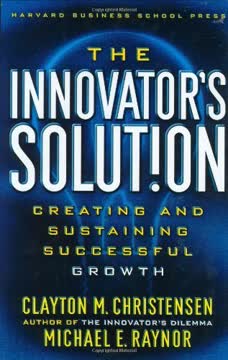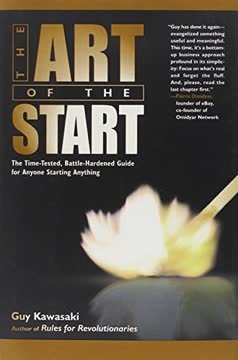Key Takeaways
1. Customer Development is crucial for startup success
The goal of Customer Development is not to collect feature lists from prospective customers, nor is it to run lots of focus groups.
Rethink traditional product development. The Customer Development model challenges the conventional wisdom of building a product first and then trying to find customers. Instead, it emphasizes learning and discovery about customers and their problems before fully developing the product. This approach reduces the risk of building something nobody wants.
Four-step process. The Customer Development model consists of four steps:
- Customer Discovery: Understand customer problems and needs
- Customer Validation: Develop a repeatable sales process
- Customer Creation: Generate end-user demand
- Company Building: Transition to a formal organization
By following this process, startups can validate their business model and product-market fit before scaling up, significantly increasing their chances of success.
2. Market Type determines strategy and execution
Market Type changes everything — how you evaluate customer needs and customer adoption rate, how the customer understands his needs and how you would position the product to the customer.
Four Market Types. Startups generally fall into one of four categories:
- Entering an existing market
- Creating an entirely new market
- Resegmenting an existing market as a low-cost entrant
- Resegmenting an existing market as a niche player
Tailored strategies. Each Market Type requires different approaches to customer acquisition, sales, marketing, and financial projections. For example, in an existing market, the focus is on product differentiation and capturing market share. In a new market, the priority is educating customers and creating demand. Understanding your Market Type is critical for developing appropriate strategies and setting realistic expectations for growth and profitability.
3. Customer Discovery validates product-market fit
The goal of Customer Development is to see whether there are customers and a market for that vision.
Get out of the building. The first step in Customer Discovery is to test your hypotheses about customer problems and your proposed solution. This involves directly engaging with potential customers to understand their needs, workflows, and pain points. The goal is not to sell, but to listen and learn.
Iterative process. Customer Discovery is not linear but iterative. It involves:
- Developing hypotheses about customers and their problems
- Testing these hypotheses through customer interactions
- Refining the product concept based on feedback
- Repeating the process until you achieve product-market fit
This phase helps startups avoid the costly mistake of building a product that doesn't solve a real, pressing customer need.
4. Customer Validation proves the business model
The only valid way to test your assumptions is to sell the product.
Develop a sales roadmap. Customer Validation focuses on creating a repeatable sales process. This involves:
- Identifying and selling to early adopters (earlyvangelists)
- Developing a positioning strategy
- Creating a sales roadmap
- Validating the business model through actual sales
Pivot or proceed. The outcome of this phase is critical. If you can't find a repeatable sales process or if the business model isn't profitable, it's time to pivot and return to Customer Discovery. Only when you have a proven, repeatable sales process should you proceed to scaling up.
5. Customer Creation drives demand and scales sales
Market Type determines not only how this transition will occur but also the type of staffing, hiring, and spending you will need.
Market-specific strategies. Customer Creation strategies vary based on Market Type:
- Existing market: Focus on product differentiation and aggressive marketing
- New market: Emphasize customer education and market creation
- Resegmented market: Use positioning and branding to highlight your unique value proposition
Crossing the chasm. This phase addresses the challenge of moving from early adopters to the mainstream market. It involves:
- Developing appropriate marketing and sales strategies
- Creating and executing launch plans
- Scaling up demand creation activities
The key is to match your demand creation efforts to your Market Type and the stage of your market adoption.
6. Company Building transitions to mission-centric organization
Creating fast-response departments offers a natural evolution from the learning and discovery stage to the functional departments a large company needs.
Evolve the organization. As the company grows, it needs to transition from the initial Customer Development team to a more structured organization. This involves:
- Creating functional departments (sales, marketing, business development)
- Developing a mission-centric culture
- Implementing processes while maintaining agility
Balance structure and flexibility. The challenge is to build an organization that can scale while retaining the speed and adaptability of a startup. This requires a careful balance between implementing necessary processes and maintaining the entrepreneurial spirit that drove initial success.
7. Fast Response Departments maintain agility at scale
Whoever can make and implement his decisions consistently faster gains a tremendous, often decisive, advantage.
OODA loop. Fast Response Departments use the OODA loop (Observe, Orient, Decide, Act) to maintain agility:
- Observe: Gather information quickly and efficiently
- Orient: Analyze and synthesize information in the context of the company's mission
- Decide: Make rapid, decentralized decisions
- Act: Execute decisions swiftly and effectively
Decentralize decision-making. To maintain speed and flexibility, empower employees to make decisions at all levels of the organization. This requires:
- Clear communication of the company's mission and goals
- Trust in employees' judgment
- A culture that values initiative and learning from mistakes
By implementing these principles, companies can maintain startup-like agility even as they grow.
8. Founders must evolve with the company's growth stages
The irony is that just when investors need to keep the company's momentum and flexibility going to reach mainstream customers, they stumble by substituting bureaucracy, while entrepreneurs fail to adapt their management style to the very success they have created.
Leadership evolution. Founders must adapt their leadership style as the company grows:
- Early stage: Visionary, hands-on leadership focused on learning and discovery
- Growth stage: Transition to mission-centric management, delegating more responsibility
- Scale stage: Develop processes and structures while maintaining entrepreneurial spirit
Balancing act. The challenge for founders is to evolve their skills and management style without losing the passion and vision that drove initial success. This may involve:
- Developing new skills in areas like organizational management and strategic planning
- Bringing in experienced executives to complement the founding team's skills
- Learning to delegate and trust others to execute the company's vision
Successful founders recognize that their role must change as the company grows, and they proactively adapt to meet the new challenges of each stage.
Last updated:
FAQ
What's The Four Steps to the Epiphany about?
- Focus on Startups: The book provides a framework for startups to effectively develop products and find customers, emphasizing the importance of understanding customer needs.
- Customer Development Model: Steve Blank introduces the Customer Development model, consisting of four steps: Customer Discovery, Customer Validation, Customer Creation, and Company Building.
- Contrast with Traditional Approaches: This model contrasts with traditional product development, which often leads to failure by not prioritizing customer needs.
- Learning from Experience: The author shares insights from his entrepreneurial journey, illustrating how successful startups follow a repeatable process to mitigate risks and achieve growth.
Why should I read The Four Steps to the Epiphany?
- Practical Guidance: The book offers actionable strategies for entrepreneurs to navigate the uncertainties of starting a new business.
- Foundation for Lean Startup: It is considered a foundational text for the Lean Startup movement, influencing many entrepreneurs and educators.
- Real-World Examples: Steve Blank uses case studies and personal anecdotes to illustrate key concepts, making the material relatable and easier to understand.
What are the key takeaways of The Four Steps to the Epiphany?
- Customer Development is Crucial: Startups must prioritize customer development over product development to understand customer problems and validate solutions.
- Iterative Process: The Customer Development model is iterative, encouraging startups to refine their hypotheses based on customer feedback.
- Market Types Matter: Recognizing which market type a startup falls into can significantly influence its approach to customer acquisition and product development.
What is the Customer Development model in The Four Steps to the Epiphany?
- Four Steps: The model consists of Customer Discovery, Customer Validation, Customer Creation, and Company Building, each focusing on different aspects of customer engagement.
- Iterative Learning: It encourages learning from customers through direct engagement and feedback, refining product offerings and business strategies.
- Separation from Product Development: Unlike traditional approaches, it emphasizes discovering and validating customer needs before product development.
What is Customer Discovery in The Four Steps to the Epiphany?
- Identifying Customer Problems: This phase focuses on understanding who the customers are and what problems they face.
- Testing Hypotheses: Startups formulate and test hypotheses about the product and customer needs with potential customers.
- Earlyvangelists: The concept of "earlyvangelists" refers to customers willing to take risks on new products, crucial for feedback and validation.
What is Customer Validation in The Four Steps to the Epiphany?
- Proving the Sales Roadmap: This phase aims to establish a repeatable sales process and validate the business model.
- Sales Roadmap Development: It involves creating a sales roadmap that outlines how to sell the product effectively.
- Feedback Loop: Gathering feedback from customers to refine the product and sales strategy is essential in this iterative process.
How does The Four Steps to the Epiphany define Customer Creation?
- Focus on Demand Generation: Customer Creation is about generating demand for the product after validating it with early customers.
- Positioning and Messaging: Emphasizes clear positioning and messaging that resonates with target customers.
- Ongoing Process: It requires continuous engagement with customers, adapting strategies based on market feedback and changing needs.
What are the four types of startups mentioned in The Four Steps to the Epiphany?
- Existing Market: Startups introduce a new product into an established market, facing competition from existing players.
- Resegmented Market: Startups redefine or resegment an existing market, offering unique value propositions to specific segments.
- New Market: Startups create entirely new markets with innovative products, often needing to educate customers.
- Low-End Market: Startups target the lower end of an existing market with simpler, cheaper alternatives.
What is the significance of Market Type in The Four Steps to the Epiphany?
- Guides Strategy Development: Market Type influences the strategies a startup should adopt for sales, marketing, and product development.
- Risk Assessment: Helps startups assess risks associated with entering a market, such as competition and market dynamics.
- Resource Allocation: Informs how startups allocate resources to maximize success, tailoring strategies to the Market Type.
What are some best practices for Customer Development outlined in The Four Steps to the Epiphany?
- Engage with Customers Early: Startups should prioritize engaging with customers from the outset to validate their assumptions.
- Iterate Based on Feedback: The process is iterative, requiring startups to adjust their hypotheses based on customer insights.
- Build Relationships with Earlyvangelists: Cultivating relationships with earlyvangelists provides critical feedback and support.
What are the common pitfalls startups face according to The Four Steps to the Epiphany?
- Ignoring Customer Needs: Focusing too heavily on product development without validating customer needs can lead to failure.
- Premature Scaling: Scaling operations before establishing a solid customer base and sales process can lead to unsustainable growth.
- Misunderstanding Market Types: Failing to recognize the market type can lead to inappropriate strategies for customer engagement and product positioning.
What are the best quotes from The Four Steps to the Epiphany and what do they mean?
- "Startups are not smaller versions of large companies.": Emphasizes that startups require different strategies than established businesses.
- "The goal of Customer Development is to discover what customers really want.": Highlights the importance of understanding customer needs for building successful products.
- "No business plan survives first contact with customers.": Underscores the necessity of flexibility and adaptability in the startup process.
Review Summary
The Four Steps to the Epiphany is highly regarded for its customer-centric approach to startups. Readers praise its valuable insights on customer discovery, validation, and market segmentation. The book is considered essential for entrepreneurs, offering practical advice on building successful businesses. While some find it dense and occasionally verbose, many appreciate its detailed methodology and real-world applicability. Critics note its focus on B2B companies and dated examples, but overall, it's seen as a foundational text for lean startup methodologies and customer development processes.
Similar Books










Download PDF
Download EPUB
.epub digital book format is ideal for reading ebooks on phones, tablets, and e-readers.





